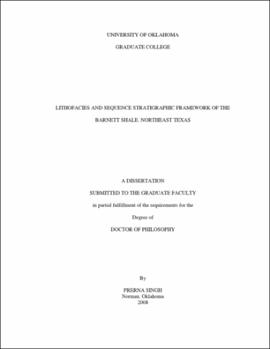| dc.contributor.advisor | Slatt, Roger M. | |
| dc.creator | Singh, Prerna | |
| dc.date.accessioned | 2019-05-01T17:23:25Z | |
| dc.date.available | 2019-05-01T17:23:25Z | |
| dc.date.issued | 2008 | |
| dc.identifier | 99117927402042 | |
| dc.identifier.uri | https://hdl.handle.net/11244/319420 | |
| dc.description.abstract | The Barnett Shale, Northeast Texas, is a self-contained petroleum system (Jarvie, 2005). The Newark East field (Barnett Shale, TX) is the second largest producing field of natural gas in the U.S (EIA 2006 Annual Reserve Reports) and the Barnett Shale, Fort Worth Basin is projected for 374 bcf of annual production by 2010 (EIA, 2004). The depositional history and sequence stratigraphy of the Barnett Shale is not fully known. This dissertation establishes Barnett Shale sequence stratigraphy based on observations of continuous cores and wireline logs, integrated with analytical data. | |
| dc.description.abstract | Four continuous long cores from Denton, Wise, and Parker counties, Texas have been studied to document the detailed internal stratigraphy and architecture of the Barnett Shale. Visual, petrographic and mineralogic analysis reveals nine distinct lithofacies within the Barnett Shale in the study area. The study indicates significance of depositional processes which have constrained the vertical facies successions and cyclicity in the study area. | |
| dc.description.abstract | The identification of a systematic and cyclic stratal stacking pattern of the lithofacies coupled with the gamma-ray log patterns led to identification of three parasequence types: upward-increasing Gamma Ray Parasequence, upward-decreasing Gamma Ray Parasequence and intervals of constant Gamma Ray Parasequence. A typical upward-decreasing Gamma ray parasequence is composed of upward-decreasing amounts of clay and phosphatic sediments accompanied by increasing allochthonous calcite grains, and capped with a reworked shelly deposit. This pattern is indicative of upward-shoaling of the depositional environment during a very gradual fall in relative sea level. An upward-increasing Gamma Ray Parasequence consists of upward-decreasing amounts of calcareous sediments and increasing amounts of clay and phosphatic sediments which are indicative of a rise in relative sea level. These parasequences stack systematically to form parasequence sets which constitute systems tracts. | |
| dc.description.abstract | The Lower Barnett Shale is composed of nine and the Upper Barnett Shale is composed of five Gamma Ray parasequences and parasequence sets in the `core area'. Their comparison and correlation between different locations suggests the lateral facies variability which has been explained as a function of sediment source area distance and accommodation space. Thickness maps of these Gamma Ray parasequences and parasequence sets reveal changing thickness trends. | |
| dc.description.abstract | Thus, by integrating several attributes and scales of observations, from logs to subsurface cores to thin sections and incorporating geochemical parameters, this study establishes the sequence stratigraphy of the Barnett Shale. The study also provides a workflow for systematically constructing a sequence stratigraphic framework for mudstones of similar setting. | |
| dc.format.extent | 198 pages | |
| dc.format.medium | application.pdf | |
| dc.language | en_US | |
| dc.relation.requires | Adobe Acrobat Reader | |
| dc.subject | Oil-shales--Texas | |
| dc.subject | Sequence stratigraphy | |
| dc.subject | Lithofacies--Texas | |
| dc.title | Lithofacies and Sequence Stratigraphic framework of the Barnett Shale, Northeast Texas | |
| dc.type | text | |
| dc.type | document | |
| dc.thesis.degree | Ph.D. | |
| ou.group | Mewbourne College of Earth and Energy::ConocoPhillips School of Geology and Geophysics | |
